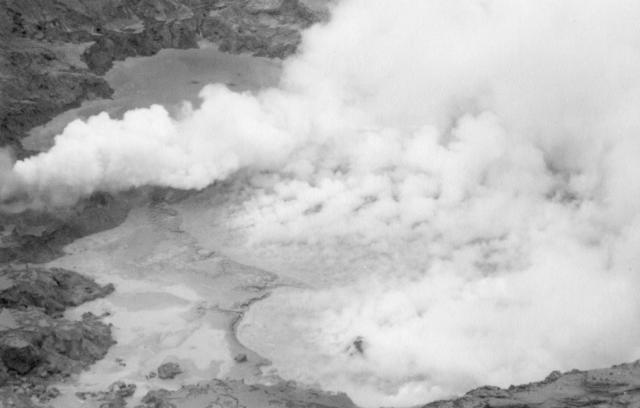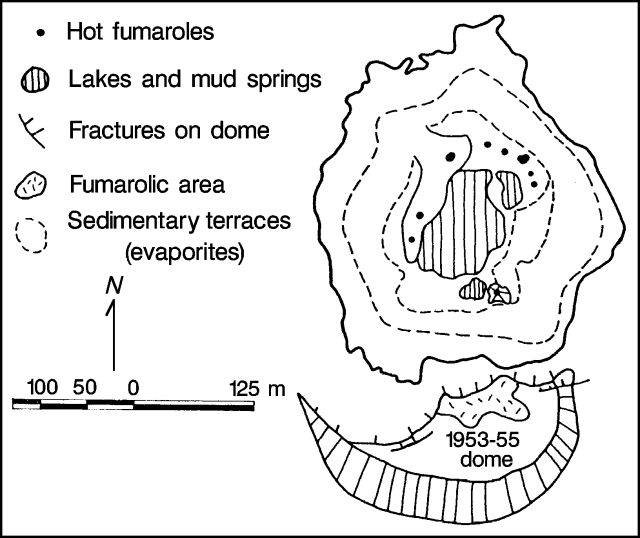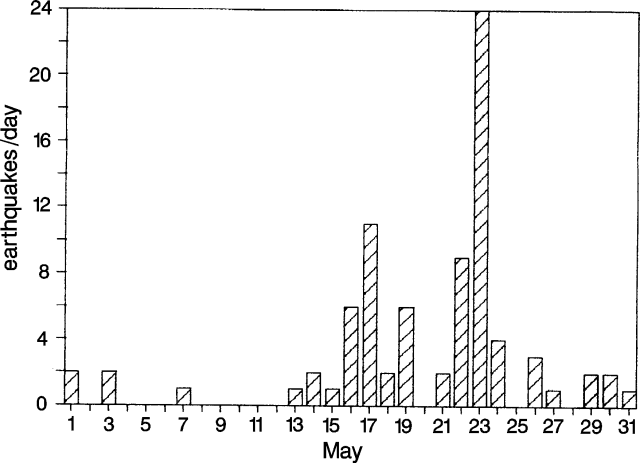Report on Poas (Costa Rica) — May 1990
Bulletin of the Global Volcanism Network, vol. 15, no. 5 (May 1990)
Managing Editor: Lindsay McClelland.
Poas (Costa Rica) Strong gas emissions but phreatic activity decreases; small lake and mud/sulfur cones in crater
Please cite this report as:
Global Volcanism Program, 1990. Report on Poas (Costa Rica) (McClelland, L., ed.). Bulletin of the Global Volcanism Network, 15:5. Smithsonian Institution. https://doi.org/10.5479/si.GVP.BGVN199005-345040
Poas
Costa Rica
10.2°N, 84.233°W; summit elev. 2697 m
All times are local (unless otherwise noted)
May activity was less intense than in April, but similar to that of previous months. Strong gas emissions occurred from fumaroles in the crater and there were at least two mud eruptions that reached heights of several hundred meters, one at roughly 0800 on 4 May, the other on 8 May. ... The crater lake had shrunk substantially, to a small feature, several centimeters deep, that fluctuated slightly with changes in rainfall recharge. Lake temperatures were >72°C (measured by infrared thermometer) and small hot springs around the lake had temperatures of 85°C. Small cold springs from the E wall of the crater had pH values of 1.5. Fumaroles on the 1953-55 dome emitted gas (91 ± 1°C), primarily water vapor, and precipitated sulfur.
The most vigorous fumaroles were in the NE, SE, and NW parts of the crater (figures 29 and 30). The latter formed a NNE-SSW line of mud/sulfur cones that grew during the climax of activity at the end of April. In mid-May, the southernmost fumarole had a diameter of 5 m and the emitted gases were burning (the exothermic reactions required temperatures much greater than 230°C). On 30 May flames were not visible, but there was intense intermittent fumarolic activity at this and other vents.
 |
Figure 29. View of the active crater at Poás on 23 May 1990, looking roughly N from the 1953-55 dome. Courtesy of Rafael Barquero. |
In the SE part of the lake there were collapsed cones with peripheral boiling mud springs and fumaroles (temperatures at 90-100°C) precipitating sulfur. On 16 May a squat, subconical structure with multiple fumaroles was noted (115°C), but no longer existed 2 days later, having been reclaimed by the boiling mud springs in the lake. The greatest activity occurred in the NE part of the lake. Mud/sulfur cones were periodically constructed and destroyed in the middle of a group of fumaroles and boiling springs. Emissions were rich in sprays of elemental sulfur or sulfur-colored oxides as well as water vapor. In mid-May, several of the NE cones ejected elongate blebs of mud to 20 m height, but this behavior was not observed at the end of the month. At least one of the NE fumaroles emitted gases at high pressure, making a jet aircraft sound. On 30 May, the most active fumarole was located against the sedimentary terrace and had a diameter of 2 m.
Park guards reported the occurrence of eye and respiratory irritation during changes in wind direction that caused acid volcanic gases to blow S towards the tourist center and overlook. Guards have recommended that tourists spend only short periods of time at the overlook and in the park during these periods. During extreme conditions guards have evacuated the site. Continued degassing at the volcano had a major impact on vegetation on the W and SW flanks, and on the health and the living conditions of local residents. The Costa Rican goverment declared a local state of emergency.
No unusual seismic activity occurred in May. The Univ Nacional reported that the number of low-frequency (B-type) events averaged 325 daily, similar to March (337/day) and April (301/day). There continued to be very few high-frequency (A-type) events, averaging 3 daily with magnitudes
Geological Summary. The broad vegetated edifice of Poás, one of the most active volcanoes of Costa Rica, contains three craters along a N-S line. The frequently visited multi-hued summit crater lakes of the basaltic-to-dacitic volcano are easily accessible by vehicle from the nearby capital city of San José. A N-S-trending fissure cutting the complex stratovolcano extends to the lower N flank, where it has produced the Congo stratovolcano and several lake-filled maars. The southernmost of the two summit crater lakes, Botos, last erupted about 7,500 years ago. The more prominent geothermally heated northern lake, Laguna Caliente, is one of the world's most acidic natural lakes, with a pH of near zero. It has been the site of frequent phreatic and phreatomagmatic eruptions since an eruption was reported in 1828. Eruptions often include geyser-like ejections of crater-lake water.
Information Contacts: R. Barquero and G. Soto, ICE; Mario Fernandez and Hector Flores, UCR; E. Fernández, J. Barquero, and V. Barboza, OVSICORI.



